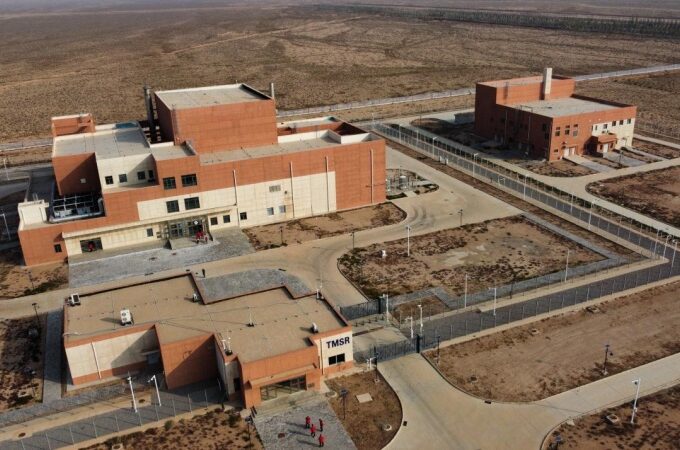In the context of the constantly evolving global energy landscape, shale oil is moving from behind the scenes to the forefront, emerging as an emerging force that reshapes the energy landscape. This petroleum resource hidden within the shale formation is gradually changing the global energy supply and consumption patterns with its unique charm and continuously innovative technologies.
What is Shale Oil?
Shale oil is not petroleum that flows freely in conventional oil reservoirs. Instead, it refers to the petroleum resources contained in the shale formation, mainly composed of shale. It is hidden in the tiny pores and fractures of the shale, including the oil in the pores and fractures of the mud shale, as well as the oil in the adjacent and interbedded layers of dense carbonate rocks or clastic rocks within the mud shale formation. This special state of occurrence makes shale oil distinct from conventional oil from the very beginning.
In terms of physical properties, shale oil usually appears as a brown paste at room temperature, with a relatively large specific gravity, generally between 0.85 and 1.00, and it also has a unique pungent odor. In terms of chemical composition, shale oil has a high water content, fewer alkanes, but is rich in olefins and aromatic hydrocarbons. At the same time, it contains more non-hydrocarbon components such as nitrogen and sulfur, as well as various metal components. Shale oil in different regions varies greatly in density, wax content, freezing point, asphaltene, and elemental composition due to differences in geological conditions. However, the weight ratio of carbon to hydrogen is basically around 7 to 8, which makes it the liquid fuel closest to natural petroleum and with the greatest potential to replace natural petroleum.
Shale Oil Distribution
The global shale oil resources are widely distributed but not evenly. North America, with its abundant shale oil reserves, especially the United States, holds an important position in the global shale oil field. The United States has numerous shale oil production areas. Among them, the Barnett Shale production area in Texas is renowned far and wide, contributing almost two-thirds of the onshore crude oil production in the United States and helping the United States become the world’s largest crude oil producer. South America also has considerable shale oil resources. The Orinoco Heavy Oil Belt in Venezuela, although mainly composed of heavy oil, also has a significant potential reserve of shale oil.
In North Africa, countries such as Libya and Algeria are also rich in shale oil resources. The shale oil in these regions was mostly formed during specific geological historical periods. In a marine sedimentary environment, the shale layers rich in organic matter provided the material basis for the generation of shale oil. Russia also plays an important role in the shale oil field. Its vast Siberian region is believed to contain a large amount of shale oil resources. Countries and regions such as China and Mongolia in Asia, as well as Australia in Oceania, also have shale oil deposits. However, there are differences in reserve scale and development degree compared with the above regions.
According to the assessment of relevant research institutions, the technically recoverable shale oil resources globally are quite substantial, providing a huge potential support for the global energy supply. Although the accurate reserve data are still being continuously explored and evaluated, new shale oil production areas are constantly being discovered and confirmed, which undoubtedly injects new vitality into the global energy landscape.

Evolution of Shale Oil Extraction Technologies
The development of shale oil extraction technology is a story of continuous breakthroughs and innovation. In its early days, extracting oil from shale posed numerous challenges—high costs and low efficiency made commercial production difficult. It wasn’t until hydraulic fracturing and horizontal drilling technologies achieved key breakthroughs that the shale oil industry began to flourish.
Hydraulic fracturing involves injecting high-pressure fluid—typically a mixture of water, sand, and chemical additives—into shale formations. The intense pressure creates fractures in the rock, allowing trapped oil to flow more freely. The sand particles act as proppants, holding the fractures open even after the pressure is released, which dramatically increases the permeability of the shale and enables the oil to flow into the well more efficiently.
Horizontal drilling took a different approach from traditional vertical wells by allowing the wellbore to extend laterally within the shale layer. This innovation significantly increased the contact area between the well and the oil-rich formation, essentially laying down more “straws” through the rock. As a result, a single horizontal well often yields several times more oil than a vertical one, greatly enhancing the economic viability of shale oil production.
As technology continues to evolve, microseismic monitoring has emerged as a crucial advancement. During the fracturing process, this technology tracks microseismic events caused by the formation of new fractures. By analyzing these signals, engineers can accurately determine the direction, extent, and geometry of the fractures, allowing them to optimize fracturing strategies and improve results.
Geological modeling and reservoir simulation also play vital roles in shale oil extraction. By integrating vast amounts of geological, geophysical, and production data, engineers can build accurate models of the shale reservoir. These models simulate fluid flow within the reservoir, helping oil companies better understand shale oil distribution and develop scientifically sound extraction plans.
Impact of Shale Oil on the Global Energy Landscape
The large-scale development and utilization of shale oil are profoundly reshaping the global energy landscape. From the supply side, the United States, with the explosive growth of its shale oil production, has achieved a transformation from a major oil-importing country to an exporting country. This transformation has broken the long-term dominance of traditional oil-producing regions such as the Middle East in the global oil supply, and the global oil supply pattern has shown a diversified trend.
Data from the International Energy Agency (IEA) shows that in recent years, the shale oil production in the United States has continued to rise, having a profound impact on the global oil market supply. When the global oil supply is tight, U.S. shale oil producers can quickly increase production to stabilize the market supply; when there is an oversupply, they can flexibly adjust the production scale to avoid excessive market fluctuations. On the demand side, the emergence of shale oil has provided more choices for the energy consumption market. Some countries and regions that originally relied on imported oil have begun to increase the development of their domestic shale oil resources, reducing their dependence on external oil supplies and enhancing the stability and security of their energy supplies.
In terms of international oil prices, the impact of shale oil is also crucial. In the past, international oil prices were mainly dominated by traditional oil-producing organizations such as the Organization of the Petroleum Exporting Countries (OPEC). But with the increase in shale oil production, its influence on the international oil price formation mechanism has gradually increased. The extraction cost of shale oil is relatively high, which sets a certain lower limit for international oil prices to a certain extent. When oil prices are too low, shale oil producers reduce extraction, and the reduced supply drives up oil prices; when oil prices are too high, the increase in shale oil production suppresses further price increases, making the fluctuation range of international oil prices more reasonable.

Challenges Faced by the Development of the Shale Oil Industry
Although shale oil has broad prospects, its development path is not smooth sailing. The most pressing issue is the extraction cost. Shale oil extraction relies on complex technologies and specialized equipment, and huge capital investments are required in the early stages of exploration, drilling, fracturing, and other links. Even with the cost reduction due to technological progress, its extraction cost is still generally higher than that of traditional oil.
Taking the United States as an example, in some shale oil production areas, when the oil price is lower than $50 per barrel, the economic benefits of extraction will be greatly reduced. Once the international oil price remains low for a long time, many shale oil projects will face losses, and the investment willingness of enterprises will decrease, thereby affecting the development of the entire shale oil industry. Environmental issues are also a major obstacle to the development of the shale oil industry. The hydraulic fracturing process requires a large amount of water resources. According to statistics, each shale oil well may require millions of gallons of water for fracturing. Most of these water resources are difficult to recycle, and in water-scarce areas, it may trigger water use conflicts. At the same time, the chemical substances in the fracturing fluid may contaminate groundwater, and the emissions of greenhouse gases such as methane generated during the extraction process cannot be ignored, hurting the global climate.
In addition, the geological conditions of shale oil reservoirs are complex, and it is difficult to accurately evaluate the reserves and recoverability. Shale oil reservoirs in different regions vary significantly in rock properties, oil saturation, pore structure, etc. The existing exploration and evaluation technologies still have certain limitations, which may lead to misjudgments of the resource quantity and affect the development decision-making.
Future Development Trends
Looking ahead, technological innovation will continue to drive the development of the shale oil industry. On the one hand, the extraction technologies will continue to be optimized and upgraded. For example, more efficient fracturing fluid formulations will be developed to improve the fracturing effect while reducing the environmental impact; the horizontal drilling technology will be improved to further increase the drilling efficiency and the contact area between the wellbore and the shale formation, reducing the extraction cost. On the other hand, digital and intelligent technologies will be deeply integrated into the shale oil extraction process. Through technologies such as the Internet of Things, big data, and artificial intelligence, real-time monitoring and intelligent control of well production can be achieved. According to the dynamic changes of the reservoir, the extraction parameters can be adjusted promptly to improve production efficiency and resource recovery rates.
Against the backdrop of the global energy transition, shale oil will also find its position in the energy structure. With the rapid development of renewable energy, shale oil is unlikely to completely replace traditional oil and natural gas. However, it will serve as a transitional energy source, playing an important role in meeting energy demands and ensuring energy security. At the same time, the shale oil industry will also pay more attention to sustainable development, increasing investment and technological research and development in environmental protection, water resource recycling, greenhouse gas emission reduction, etc., to achieve a balance between economic benefits and environmental benefits.
As an emerging force in the energy field, shale oil is attracting the attention of the world with its unique resource characteristics, continuously innovative extraction technologies, and far-reaching impact on the global energy landscape. Although facing many challenges, it has great development potential in the future and is expected to write a more glorious chapter on the global energy stage, contributing significantly to the sustainable development of the human energy cause.












